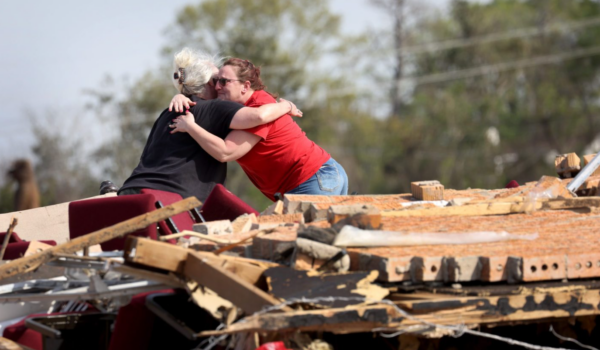Sharkey County, Mississippi, was devastated by tornadoes. A single incident killed almost 20 individuals. Due to greater building construction, U.S. natural catastrophes kill fewer people than similar incidents in underdeveloped countries.
A 2021 Federal Reserve study found that 16% of Americans were affected by natural catastrophes, with property destruction being the most prevalent.
Americans struggle to prepare for climate-related crises. My parents feared for me in an earthquake when I relocated to downtown Los Angeles in 2009. My parents imagined my 1911 office building, converted to condos, falling like an accordion after almost 100 years. They sent me a solar-powered radio, flashlight, first aid kit, and notes to stock up on bottled water.
Even with the finest science, tornadoes, earthquakes, and other calamities cannot be predicted. Despite uncertainty, there are ways to decrease hazards to our homes, neighborhoods, and finances. While acknowledging individual boundaries, we should invest in collective plans.

Prepare for which risks?
Natural catastrophe risk identification is difficult. Many of us can foresee that California is prone to earthquakes and Florida to hurricanes. Most U.S. locales have numerous dangers. A major earthquake in Southern California is 75% likely in 30 years. From 1950 to 2017, 7% of the state’s emergency declarations were earthquake-related, compared to 40% for floods and 30% for fires.
Due of our unpreparedness, less evident threats often inflict the most harm to our houses and infrastructure. The Pacific Northwest has moderate summers and few residences have air conditioning, so an unexpected heat wave poses increased public health hazards, especially for older persons and other vulnerable groups. Texas and Mississippi homes are intended for hot weather, but cold spells can freeze pipes and flood homes.
Natural geography and built environment factors impact natural catastrophe susceptibility at local scales. According to the Environmental Protection Agency’s interactive climate change mapping tool, certain downtown Los Angeles city blocks have a flooding risk below the 50th percentile, while others less than a mile away, along the Los Angeles River, are over the 90th percentile.
Geospatial tools that map climate risk by neighborhood or property are now available to the public. It’s unclear how or if this information will affect housing decisions. Most Americans won’t choose locations based on climate hazards. Jobs, family, and climate (sunshine and warm temps) determine where people reside.
Yet, climate mapping technologies may help consumers choose safer neighborhoods in their selected city. Redfin found that providing prospective homebuyers property-level climate risk rankings can persuade them to choose lower-risk houses. Local climate risk may become another neighborhood characteristic individuals study before moving or buying a property, like subway stops or restaurants.
Earthquakes, wind, water, and fire.
While downtown Los Angeles was home to banks and other financial institutions in the 1910s and 1920s, several high-rise structures were built. After World War II, the city center relocated west, leaving scores of mainly empty buildings. The city established an Adaptive Reuse Code in the 1990s to turn existing commercial buildings into houses as downtown housing demand increased.
By then, architects and engineers had devised better seismic-protection methods for big structures in LA and the Bay Area. The developer transformed a disused office building into condos to meet contemporary construction regulations. Seismic improvements cost $40,000 to over $1 million for modest to big structures. They safeguard buildings and individuals in earthquakes.
Seismic retrofits are one way building technologies, materials, and methods may protect against natural catastrophes and climatic events. Western states need fire-resistant exterior construction materials, whereas Florida requires wind-fortified roofs and windows. Nevertheless, building code updates seldom apply retrospectively, and many older homes cannot handle today’s climate demands without significant renovations and care. The average American house is almost 40 years old—the oldest ever. Mobile homes—30% of Sharkey County, MS’s homes—are inexpensive yet vulnerable to storms and tornadoes.
Technical advice and financial math are needed to determine whether structural modifications will make your property safer. Pruning vegetation around your house reduces wildfire danger at a low cost, while replacing wood exterior components with fire-proof masonry might cost over $60,000. Many homeowners can’t afford home equity loans, but those with strong credit and high-value properties may. Renters can seek safety upgrades from their landlords, but they cannot change the structure of their properties.
Homeowners or renters’ insurance fine print
Standard property insurance plans cover only a portion of the collateral, but mortgage lenders need it. Notably, floods and earthquakes are not covered. Natural catastrophe insurance is pricey. (Only about 10% of California homeowners have earthquake insurance.) Homeowners in high-flood-risk areas who have federally backed mortgages must buy flood insurance through the federal National Flood Insurance Program, but a changing climate is increasing the frequency and size of insurance payouts, putting financial pressure on both private and public insurance programs.
Tenants should purchase property insurance to protect their valuables. Renting is better than buying in high-risk climates like South Florida beachfront property. Tenants only remain for the term of the lease (typically one year), and diversified financial assets like mutual funds are less vulnerable to climate risk than investing all one’s life savings into the down payment on a single property that may be underwater in 10 years.
Risk paradox
Creating a home climate and natural disaster action plan is only the beginning. Other obstacles include motivating and supporting employees to execute these goals. Florida had the largest population increase in 2022 because people adore beaches and sunlight. Because Houston flood-prone communities are inexpensive, poor people reside there.
Individual efforts are limited. Living in places where buildings and infrastructure have been adapted to resist natural catastrophes makes us safer. Vulnerable communities are poorly served by federal disaster recovery programs. Our housing, land use, and transportation systems also impact the environment. Beyond merely preaching to the choir, these greater aims need forging broader political alliances.
My parents’ catastrophe kit wasn’t needed. Due to the building’s outstanding seismic retrofits, I slept through the greatest earthquake in my five years in LA at 5 a.m. Or luck.

